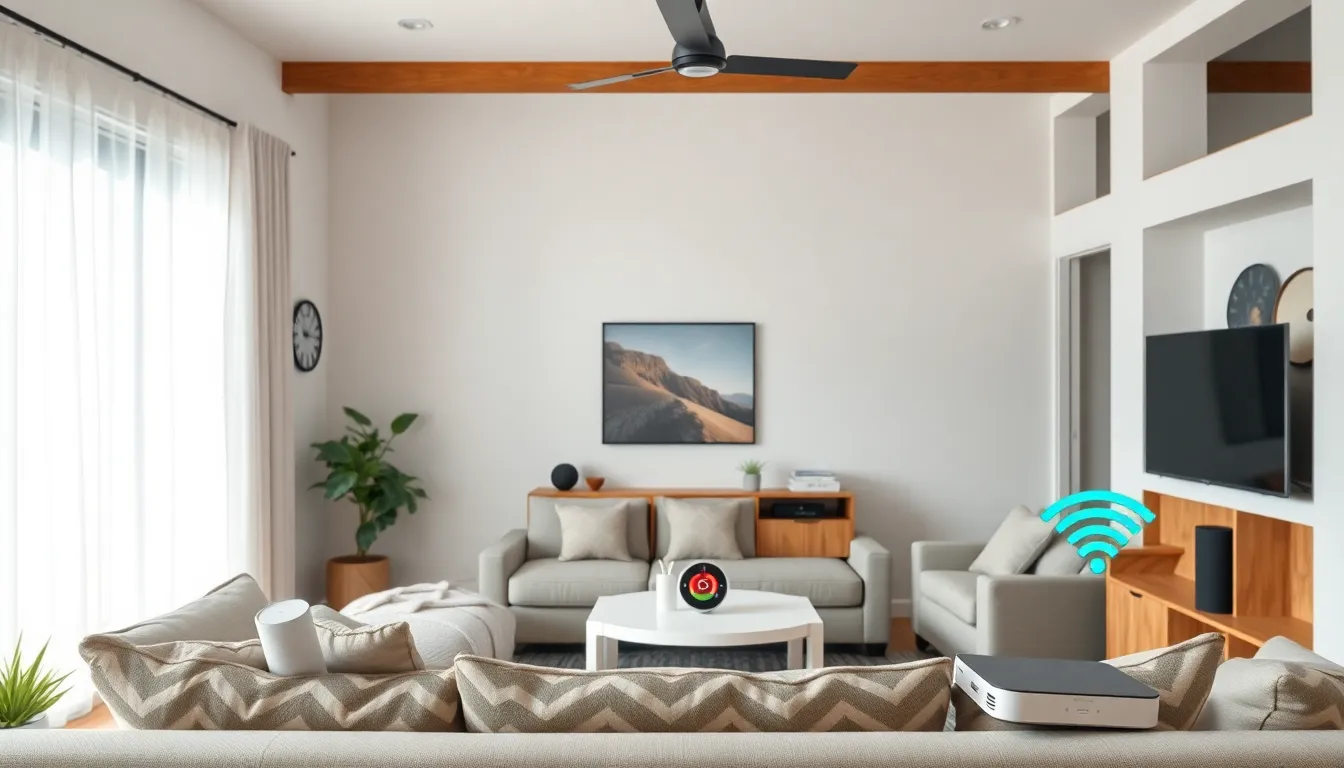In today’s tech-savvy world, a smart home isn’t just a luxury—it’s practically a necessity. Imagine controlling everything from your lights to your coffee maker with just a tap on your phone. Sounds great, right? But without a solid Wi-Fi and networking setup, all those fancy gadgets might as well be paperweights.
Table of Contents
ToggleOverview of Smart Home Wifi and Networking
Smart home Wi-Fi and networking serve as the foundation for device connectivity. Reliable internet access enables seamless communication between smart home devices like security cameras, smart thermostats, and voice assistants. Fiber optic or high-speed cable connections often provide the best performance, ensuring smooth operation.
A mesh network offers significant advantages for larger homes. This system allows multiple access points to extend coverage throughout the entire space. Eliminating dead zones enhances user experience by maintaining consistent connectivity.
Security becomes a crucial consideration when setting up networks. Implementing strong, unique passwords for the Wi-Fi network protects against unauthorized access. Regular firmware updates on routers and devices also mitigate vulnerabilities, ensuring robust protection.
Bandwidth management enhances performance for numerous connected devices. Prioritizing critical applications like video streaming over less important tasks ensures smooth operation. Many modern routers feature Quality of Service (QoS) settings for effective bandwidth allocation.
Understanding the Internet of Things (IoT) is vital for integrating smart devices into a home network. Each IoT device requires its own IP address, which routers assign for proper communication. Knowledge of these requirements helps optimize connectivity and overall performance.
By considering these factors, a homeowner can maximize the potential of their smart home ecosystem. Successful implementation leads to a more efficient and responsive living environment. Engaging with reliable Wi-Fi and networking not only enhances convenience but also elevates the smart home experience.
Benefits of Smart Home Wifi

Smart home Wi-Fi enhances device connectivity and boosts overall efficiency. These advantages depend on strong networks to support multiple devices.
Enhanced Connectivity
Enhanced connectivity ensures devices communicate seamlessly. A high-speed internet connection supports smart home applications like security cameras, thermostats, and voice assistants. Using fiber optic or high-speed cables helps optimize this connectivity. Mesh networks effectively eliminate dead zones, delivering coverage across larger homes. With reliable Wi-Fi, homeowners experience smoother interactions and quicker response times. Smart devices, including smart bulbs and locks, operate more efficiently, contributing to an integrated ecosystem.
Increased Security
Increased security provides peace of mind for users. A strong and unique password safeguards against unauthorized access. Regular firmware updates enhance device security, protecting sensitive information. Implementing network segmentation isolates smart devices from personal devices, adding an extra layer of protection. Additionally, monitoring network traffic can help identify unusual activity. Utilizing advanced encryption methods further secures data transmission. Smart home Wi-Fi enhances safety, ensuring that the entire system functions securely.
Best Practices for Setting Up Smart Home Wifi
Setting up a smart home Wi-Fi network involves key considerations to ensure optimal device performance and security.
Choosing the Right Router
Selecting the appropriate router impacts overall connectivity. A dual-band or tri-band router provides better performance by allowing devices to connect more efficiently. Features like Quality of Service (QoS) are essential, as they enable prioritization of critical applications, enhancing device interaction. Research often indicates that routers with advanced security protocols offer better protection against unauthorized access. Updated firmware significantly contributes to the router’s performance and security, preventing vulnerabilities in the network.
Optimal Placement of Devices
Device placement plays a vital role in signal strength. Central locations typically yield more uniform coverage throughout the home. Avoid placing routers near thick walls or metal objects that can obstruct signals. Elevating the router off the ground can also enhance performance by reducing interference. It’s crucial to measure signal strength at various points in the home to identify weak areas, facilitating adjustments as needed. Using Wi-Fi extenders or a mesh network can eliminate dead zones in larger spaces, ensuring all devices maintain a strong connection.
Common Issues with Smart Home Wifi
Smart home Wi-Fi systems often face unique challenges that can affect overall performance. Understanding these issues helps ensure a seamless smart home experience.
Interference and Connectivity Problems
Wireless interference disrupts communication among devices, affecting performance. Common sources include microwaves, cordless phones, and neighboring Wi-Fi networks. Placing Wi-Fi routers away from these sources minimizes disruptions. Additionally, walls, particularly those made of metal or concrete, weaken signals. Dead zones can arise in large homes, complicating device connectivity. Implementing a mesh network can resolve this issue, providing broader coverage and eliminating dead zones. Using dual-band or tri-band routers also supports multiple devices effectively, ensuring a stable connection.
Security Vulnerabilities
Many smart home devices are susceptible to cyber threats, highlighting the need for stringent security measures. Using strong, unique passwords for each device significantly reduces unauthorized access. Regular firmware updates protect against newly discovered vulnerabilities. Network segmentation creates separate zones for smart devices and personal devices, enhancing overall security. Employing a guest network limits access to primary devices while maintaining functionality. Awareness of common security risks associated with IoT devices promotes proactive measures. Together, these strategies help safeguard the smart home ecosystem from potential attacks.
Future Trends in Smart Home Networking
Smart home networking continues to evolve with advancements in technology. Wi-Fi 6 and Wi-Fi 6E provide faster speeds and greater efficiency for multiple devices. These advancements enhance connectivity and support the increasing number of smart devices homeowners adopt.
Next-generation mesh networks deliver improved coverage and eliminate dead zones. These systems use multiple nodes to create a seamless connection throughout the home. Enhanced performance becomes crucial as more devices join the network, ensuring consistent and reliable communication.
Integration of artificial intelligence (AI) into smart home systems streamlines network management. AI can optimize bandwidth usage and automatically adjust settings based on user behavior. Such intelligent systems enhance user experience by prioritizing critical applications and managing resources effectively.
Security remains a top priority in smart home networking. Adoption of newer protocols, like WPA3, strengthens authentication methods and protects sensitive data. Regular firmware updates become essential to safeguard against vulnerabilities.
The rise of edge computing also transforms smart home functionality. By processing data locally, devices can respond faster to commands without relying on cloud services. This shift reduces latency and enhances overall performance, particularly for time-sensitive applications.
In addition, adopting Internet Protocol version 6 (IPv6) supports the growing number of smart devices. Unlike its predecessor, IPv4, IPv6 provides a vastly larger address space, ensuring every device can have its own unique IP address. This capability simplifies device management and enhances connectivity.
Sustainability in smart home networking is gaining attention. Energy-efficient devices and eco-friendly materials contribute to reducing the carbon footprint. Homeowners increasingly seek solutions that align with their environmental values while maintaining high performance.
A robust Wi-Fi and networking setup is essential for any smart home. By prioritizing strong connections and security measures homeowners can unlock the full potential of their smart devices. Investing in high-quality routers and utilizing mesh networks can significantly enhance connectivity throughout the home.
As technology advances with innovations like Wi-Fi 6 and edge computing, staying informed about these trends ensures a future-proof smart home. With the right strategies in place homeowners can enjoy seamless integration of devices while maintaining a secure environment. Embracing these practices leads to a smarter more efficient living space that adapts to their needs.








